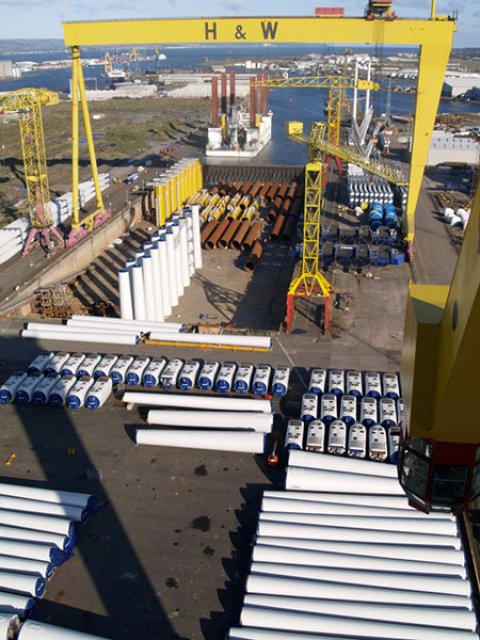As offshore wind energy develops in the United States, port facilities will become strategic hubs in the offshore wind supply chain, because all plant and transport logistics must transit through these facilities. Therefore, it is important that federa...
Wind Energy Technologies Office
October 1, 2013This is an excerpt from the Third Quarter 2013 edition of the Wind Program R&D Newsletter.
As offshore wind energy develops in the United States, port facilities will become strategic hubs in the offshore wind farm supply chain, because all plant and transport logistics must transit through these facilities. Therefore, it is important that federal and state policy-makers and port authorities understand offshore wind's ports requirements when planning future investments. The U.S. Department of Energy tasked the independent consultancy GL Garrad Hassan (GL GH) with carrying out a review of the current capability of U.S. ports to support offshore wind project development and assessing the challenges and opportunities related to upgrading this capability to support the targeted growth of as many as 54 gigawatts of offshore wind installed in U.S. waters by 2030. The GL GH report and the open-access, Web-based ports assessment tool resulting from this project will aid decision-makers in making informed decisions regarding the choice of ports for specific offshore projects, as well as the types of investments that would be required to make individual port facilities suitable to function as manufacturing, installation, and/or operations hubs.GL GH held a series of workshops, webinars, and phone conversations to gather information on ports and port use from ports officials, vessel operators, project developers, economic development interests, and other industry stakeholders around the country. Then, using a set of regional project build-out scenarios between now and 2030, they mapped out the national port infrastructure that would be required to support industry growth under the various scenarios. To facilitate a more in-depth infrastructure analysis, six ports from different geographic regions, with varied levels of interest and preparedness towards offshore wind, were evaluated by modeling a range of installation strategies and port use types to identify gaps in capability and potential opportunities for economic development. Commonalities, trends, and specific examples from these case studies are presented in the resulting report and provide a set of best practices for U.S. ports looking to support the offshore wind market. For example, the land area required for wind turbine and foundation manufacturing is substantial, particularly due to the large scale of the offshore wind components. The necessary weight-bearing capacities of the docks and large component storage areas are typically greater for offshore wind than for more conventional cargo handling. As a result, most U.S. ports will likely require soil strength improvements before they can fully support offshore wind project construction.
An important outcome of this work is the development of a Web-based port assessment tool, which allows the user to identify ports that are well-suited to specific project needs. Port operators are also able to use this tool to identify areas in which additional investments are required at their facility to support offshore wind installation and maintenance. This assessment tool is freely available to the public on the Offshore Wind Port Readiness Tool website. Read the executive summary now, which will be replaced by the full report when it becomes available.


